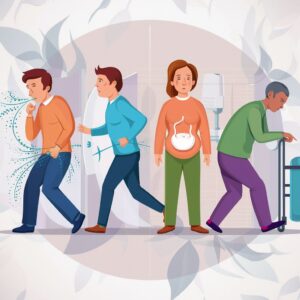Treatment Options for Incontinence Management
Incontinence is a widespread medical disease that impacts many individuals worldwide. It describes the involuntary passage of bodily fluids, such as urine or excrement, which can substantially negatively affect a person's overall well-being. The four primary categories of incontinence are stress, urge, overflow, and functional incontinence.
Every category has unique causes and symptoms. Stress incontinence is the involuntary leakage of pee that happens when the bladder is subjected to pressure. This can occur during coughing, sneezing, laughing, or exercising.
Urge incontinence is defined as a sudden and overwhelming urge to urinate, followed by the involuntary leakage of urine. When the bladder does not empty, overflow incontinence results in frequent or continuous pee dribbling. Functional incontinence commonly occurs when a person cannot reach the toilet promptly due to physical or cognitive limitations.
The aetiology of incontinence varies depending on the type. Stress incontinence often occurs due to weakening pelvic floor muscles, whereas urge incontinence may be associated with an overactive bladder or nerve impairment. Additional possible factors are urinary tract infections, constipation, specific drugs, and neurological diseases.
The symptoms of incontinence vary from slight leaking to total loss of bladder or bowel control. Individuals experiencing symptoms of incontinence should prioritise seeking medical consultation to identify the root cause and explore suitable treatment options.
Key Takeaways
- Incontinence can be caused by various factors, including weakened pelvic floor muscles, nerve damage, and certain medical conditions.
- Lifestyle changes such as maintaining a healthy weight, avoiding bladder irritants, and practising bladder training can help manage incontinence symptoms.
- Medications like anticholinergics and mirabegron can be prescribed to help control overactive bladder and reduce incontinence episodes.
- Pelvic floor exercises, also known as Kegels, and physical therapy can strengthen the pelvic floor muscles and improve bladder control.
- Surgical options, such as sling procedures and bladder neck suspension, may be considered for severe cases of incontinence that do not respond to other treatments.
 Lifestyle Changes and Behavioral Therapy for Incontinence
Lifestyle Changes and Behavioral Therapy for Incontinence
Dietary Adjustments
Making simple adjustments to daily habits can significantly reduce the frequency and severity of incontinence episodes. For example, reducing fluid intake, especially before bedtime, can help minimise the need to urinate during the night. Avoiding caffeine and alcohol, which can irritate the bladder and increase urine production, may also be beneficial.
Physical Activity and Weight Management
In addition to dietary changes, maintaining a healthy weight and engaging in regular physical activity can help strengthen the pelvic floor muscles and improve bladder control. Quitting smoking is also important, as smoking can contribute to coughing and bladder irritation, which can exacerbate incontinence symptoms.
Behavioural Therapy Techniques
Behavioural therapy techniques, such as bladder training and scheduled voiding, can help individuals regain control over their bladder function. These techniques involve gradually increasing the time between bathroom visits and learning to recognise and respond to the body's signals for urination. Furthermore, practising good toilet habits, such as taking enough time to empty the bladder and using relaxation techniques to reduce urgency, can also be helpful.
Additional Therapies
In some cases, biofeedback therapy or electrical stimulation may be recommended to help individuals gain better control over their pelvic floor muscles. By implementing these lifestyle changes and behavioural therapy techniques, many individuals with incontinence can experience significant improvement in their symptoms and regain confidence in their daily activities.
Medication Options for Managing Incontinence
Aside from making adjustments to one's lifestyle and undergoing behavioural therapy, other pharmacological choices can be used to manage incontinence effectively. The choice of medication provided will be contingent upon the incontinence's precise classification and underlying aetiology. Anticholinergic drugs are frequently employed to manage urge incontinence by inducing relaxation in the muscles of the bladder and diminishing the frequency of contractions.
These drugs can alleviate the abrupt and severe need to urinate, indicative of urge incontinence. Mirabegron is a medicine that can be administered to treat incontinence. It relaxes the bladder muscle and enhances its ability to retain urine. This medicine is commonly used for the treatment of symptoms associated with an overactive bladder, for example, the sudden and consistent urge to pee.
Topical oestrogen therapy may be prescribed for persons experiencing stress incontinence to enhance the resilience and flexibility of the tissues in the urethra and vaginal region. Tricyclic antidepressants or other drugs that impact nerve signals may be used in certain instances to assist in managing symptoms of incontinence. Individuals who are exploring drug choices for incontinence should consult a healthcare expert to establish the most suitable treatment based on their specific symptoms and medical history.
Although drugs can effectively manage incontinence for certain persons, it is essential to scrutinise their potential adverse effects.
 Pelvic Floor Exercises and Physical Therapy for Incontinence
Pelvic Floor Exercises and Physical Therapy for Incontinence
Pelvic floor exercises, usually Kegel exercises, are essential to physical therapy for managing incontinence. These exercises entail contracting and relaxing the muscles in the pelvic floor to enhance strength and control. By fortifying these muscles, individuals can improve their ability to support the bladder and bowel, decreasing the likelihood of leakage and gaining control and independence.
Pelvic floor exercises are especially advantageous for patients experiencing stress incontinence, as they enhance the capacity to retain urine during activities that exert pressure on the bladder. Physical therapy for the pelvic floor may incorporate several modalities, including biofeedback. Biofeedback employs sensors to offer visual or aural cues regarding muscle activity, aiding individuals in acquiring the skill to contract and release their pelvic floor muscles effectively by applying gentle electrical pulses to the area. It is possible to enhance pelvic floor muscle strength with electrical stimulation.
Specialised physical therapists in pelvic floor rehabilitation collaborate with patients to create customised training regimens tailored to their unique requirements and objectives. These programs may also incorporate stretches and strengthening exercises targeting additional muscle groups that support pelvic floor function. Engaging in physical therapy for incontinence can enhance patients' muscular strength and coordination, resulting in enhanced bladder control and fewer incontinence symptoms.
Surgical Options for Incontinence Treatment
Surgical interventions may be explored for those with severe or persistent incontinence that does not improve with conservative therapy. Various surgical interventions are available to treat different forms of incontinence, with each technique targeting the root cause of the disease. A frequently used surgical treatment for stress incontinence is the sling operation. This procedure entails placing a supporting sling over the urethra to offer extra support and prevent leakage when engaging in activities that strain the bladder.
A bladder neck suspension is an additional surgical technique used to treat stress incontinence. It involves attaching the neck of the bladder to adjacent structures to enhance the regulation of urine flow. For those with symptoms of an overactive bladder or urge incontinence, sacral neuromodulation may be recommended. This treatment involves placing a miniature device near the sacral nerves to regulate nerve signals associated with bladder function, diminishing the urgency and frequency of urinating.
Occasionally, surgical interventions for incontinence may involve procedures to rectify anatomical anomalies or treat underlying disorders that contribute to symptoms. Before making a decision, individuals contemplating surgical intervention for incontinence should thoroughly discuss the prospective hazards and advantages with a healthcare professional and thoughtfully evaluate their alternatives.
Incontinence Products and Devices for Management
Absorbent Products
Disposable absorbent products, such as pads, liners, and adult diapers, are commonly used to manage urinary or faecal incontinence. These products come in various sizes and absorbency levels to meet individual needs. Reusable absorbent underwear and protective garments are also available for those looking for more sustainable options.
Assistive Devices
For individuals with mobility limitations or difficulty reaching the toilet in time, portable urinals or bedpans may help manage urinary incontinence. Male external catheters and female urinary collection devices are also available for individuals who require assistance with urinary drainage.
Skin and Odor Care
In addition to absorbent products, skin care products such as barrier creams and cleansing wipes can help prevent irritation and discomfort associated with frequent exposure to urine or faeces. Odour control products, such as deodorising sprays or pouches, are also available to help manage unpleasant odours associated with incontinence.
 Combining Therapy Options for Effective Incontinence Management
Combining Therapy Options for Effective Incontinence Management
A combination of therapy approaches is often required for effective incontinence management. For instance, a person with stress incontinence can find relief by engaging in pelvic floor exercises to fortify the muscles that support the bladder. Additionally, lifestyle adjustments such as managing weight and making food alterations can help alleviate strain on the bladder. Similarly, a person with urge incontinence may find relief through pharmacotherapy to decrease the urgency and frequency of urine. Behavioural therapy strategies like bladder training can help regain control over bladder function.
Individuals with incontinence caused by several factors or complex conditions may require a comprehensive approach that incorporates various therapy approaches to control their symptoms effectively. This comprehensive care is provided by a healthcare team comprising physicians, physical therapists, occupational therapists, and other specialists. They provide individualised care based on their requirements to make people feel supported and cared for. By integrating several therapeutic approaches, persons can achieve an enhanced quality of life and restore their self-assurance in everyday activities without apprehension or unease related to incontinence.
Individuals suffering from incontinence should see healthcare professionals for assistance with the various treatment choices and to create a customised strategy that caters to their specific needs and objectives.
FAQs
What is incontinence therapy?
Incontinence therapy refers to the various treatments and interventions to manage and improve urinary or faecal incontinence symptoms. These therapies can include lifestyle changes, pelvic floor exercises, medication, medical devices, and, in some cases, surgery.
What are the common causes of incontinence?
Incontinence can be caused by a variety of factors, including weakened pelvic floor muscles, nerve damage, urinary tract infections, certain medications, and underlying medical conditions such as diabetes, Parkinson's disease, or prostate issues in men.
What are the different types of incontinence therapy?
Incontinence therapy can include pelvic floor muscle exercises (Kegel exercises), bladder training, dietary and fluid management, medication, biofeedback, electrical stimulation, and, in some cases, surgical interventions such as sling procedures or artificial urinary sphincter implants.
How effective is incontinence therapy?
The effectiveness of incontinence therapy can vary depending on the individual and the underlying cause. Many people experience significant improvement in their symptoms with the appropriate therapy, while others may require a combination of treatments to achieve the desired results.
Does insurance cover incontinence therapy?
In many cases, incontinence therapy and related treatments are covered by health insurance. However, coverage can vary depending on the specific insurance plan and the recommended therapy type. It's important to check with your insurance provider to understand what is covered and what out-of-pocket costs may be involved.
Brought To You By:
References
Tips for Dealing with Urinary Incontinence (For Men) | OncoLink. https://www.oncolink.org/support/practical-and-emotional/physical-concerns/tips-for-dealing-with-urinary-incontinence-for-men
Understanding Incontinence and Its Effects – P Homecare. https://www.phomecare.com.au/2023/05/16/understanding-incontinence-and-its-effects/
The Article: Managing Incontinence Effective Therapy Options appeared first on https://mcrtherapies.co.uk
The Article Managing Incontinence Effective Therapy Options appeared first on https://mcrtherapies.com
The Article Managing Incontinence Effective Therapy Options Was Found On https://limitsofstrategy.com
The Article Managing Incontinence Effective Therapy Options First Appeared ON
: https://ad4sc.com





Comments are closed